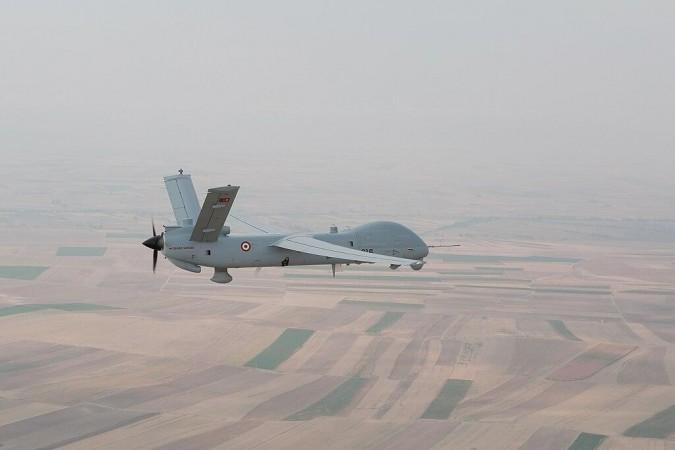
A new era of aerial defense dawned yesterday as the European Commission, rattled by a surge of mysterious drone incursions grounding flights and locking down airbases, unveiled its ambitious European Drone Defence Initiative on October 14. This continent-wide "drone wall" transforms a fledgling eastern shield against Russian provocations into a seamless fortress stretching from the Arctic Circle to the Mediterranean.
The announcement, delivered in Brussels' high-stakes corridors, isn't just Europe's answer to a sky teeming with threats it's a clarion call echoing across the globe. From Saudi Arabia's laser-laced desert barriers to India's AI-driven domes, Pakistan's swarm-powered borders, and China's hypersonic nets, nations are racing to erect invisible arsenals against cheap, swarming drones that have turned airspace into a battlefield. In 2025, a $500 quadcopter can cripple a billion-dollar asset, and the world is scrambling to rewrite the rules of sovereignty. At the heart of this revolution lies Ukraine, the war-torn crucible where drone warfare's brutal lessons birthed technologies now shaping global defenses.
This isn't a distant sci-fi saga; it's a high-stakes drama unfolding now. On October 10, "ghost UAVs" swarmed Danish skies, shuttering Billund and Aalborg airports and scrambling F-16s in a frantic chase. Similar phantoms buzzed German airbases in Schleswig-Holstein, Italian radar posts near Lampedusa, and Estonia's borders, where 15 incursions lit up sensors in one night.
Poland's September scare 20 Russian-linked Shahed drones breaching its frontier still haunts. "We've gone from vigilance to vulnerability," Danish PM Mette Frederiksen posted on X, her words hitting 50,000 likes. NATO's Mark Rutte doubled down: "We can't keep swatting fireflies with fireworks." Europe's €15 billion answer, greenlit in a marathon session, blends Ukrainian ingenuity with homegrown tech, but it's just one front in a global race where Saudi sands, Indian highlands, and Chinese coasts are forging their own shields against the drone deluge.
The Phantom Swarm: Drones Redefine Warfare
Drones have turned skies into chessboards. Silent, swarming UAVs hug treetops, spoof GPS, and vanish like smoke, democratizing disruption in 2025. Russia's October "Drone Storm" targeted Latvia's power grids and mocked Romanian defenses, while smuggler drones ferry fentanyl across the Mediterranean. In South Asia, Pakistan's kamikaze swarms probe India's borders; in the Pacific, China's WZ-7 "Soaring Dragons" stalk Taiwan. The math is merciless: Why fire a $1 million missile at a $10,000 drone? Drone walls networks of acoustic sensors, jammers, and low-cost lasers offer a scalable fix, transforming airspace into no-fly zones for rogue UAVs.The human cost stings.
Families stranded at Oslo's fogged-in runways, pilots rerouted over Munich, and Finnish airbase crews watching a drone loiter for 45 minutes, mapping missile silos before slipping into the Gulf of Finland. "It's hybrid war 2.0," a Chatham House analyst warned today. "Drones cost $500 to launch, millions to counter." Ukraine, the mother arena, knows this best: Its 1,000-km frontline has downed over 5,000 Russian Shaheds since 2022, birthing concepts now global gospel.
Ukraine: The Crucible of Drone Defense
Ukraine's battlefields are the world's R&D lab. Facing relentless Russian drone barrages, Kyiv's engineers often in Kharkiv's war-scarred garages crafted a 1,000-km "drone wall" that halted Moscow's 2024 offensives. Acoustic "ears" detect propeller whines 10 km out, feeding data to AI hubs that cue jammers to blind UAVs or mobile teams wielding machine guns and net-drones.
"We learned the hard way: Missiles don't scale," a Ukrainian commander told Reuters. "Cheap tech beats cheap threats." Innovations like sound-based Shahed trackers, EW pods on jeeps, and $200 interceptors have slashed costs from millions to pennies per kill. In 2025, Ukraine's tech exports backed by €140 billion in EU loans from frozen Russian assets are shaping defenses from Warsaw to Washington. Kyiv's "mobile hunter" units, blending Soviet-era guns with AI optics, inspired Poland's September response to 20 intruding drones. "Ukraine's not just fighting; it's teaching," said NATO's Rutte on X, where #KyivTech trends with 20,000 posts. This mother arena, forged in fire, is the blueprint for global drone walls.
Europe's Sky Shield: From Flank to Fortress
Europe's October 14 unveiling expands September's "Eastern Flank Watch" into a pan-continental web. Picture 5,000 sensors radars in the Alps, jammers on Iberian coasts, AI hubs in Warsaw linked via NATO's cloud. Ukraine's acoustic nets detect drones by buzz, jammers scramble signals, and lasers ($2 a zap) or net-drones shred them, ditching costly missiles. Southern states like Italy and Greece, stung by migrant drones at Lampedusa and the Aegean, demanded inclusion.
Funding mixes €1.5 billion from the European Defence Industry Program, €150 billion SAFE loans, and grants like Lithuania's €11 million anti-drone fund. Sensors go live by Q2 2026, intercepts by 2028. But Hungary's Orban calls it "escalatory hysteria," and France frets over asset seizure laws. Rheinmetall and Saab eye €10 billion in contracts, though skeptics ask if AI can spot a delivery drone from a danger. On X, EPP Group's "Protect our skies now!" video hit 10,000 views overnight. "It's not a wall; it's a nervous system," said Commissioner Kubilius.
Desert Defenses: Saudi's Laser Gambit
In Saudi Arabia's Shamal-2 range, September's Red Sands 2025 saw U.S. Adm. Brad Cooper witness lasers zap a 20-drone mock Houthi swarm. Riyadh's $6 billion "drone barrier" along Yemen's border fuses China's SkyShield lasers with U.S. APKWS rockets. Houthis have launched over 1,000 drones since 2015, gutting Aramco in 2019 and slashing global oil by 5%. Trials falter in 50°C heat: mirages warp beams, silica storms clog vents, cutting effectiveness by 40%. "Like firing a flashlight in a sandblaster," one operator griped. Riyadh's fix lasers for clear days, kinetics for chaos pairs with 200 MQ-9 Reapers, shifting to dominance.
The UAE invests $2 billion in Israeli jammers; Turkey markets Bayraktar swarms at IDEF 2025. Iran's drone pipeline to proxies fuels a U.S. "drone dominance" edict. Abraham Accords ease tech-sharing, but a breach could spike oil to $150/barrel. Saudi's September 17 pact with Pakistan trades billions for drone interdiction expertise, bolstering Shahpar-III swarms a hedge against waning U.S. influence, with China as enabler.
South Asian Skies: Indo-Pak Drone Duel and Triangular Aid
South Asia's skies burn. India's May 2025 Operation Sindoor saw S-400s clash with Pakistan's Chinese-sourced swarms. Pakistan's Bunyaan al-Marsoos unleashed decoy drones, ELINT birds, and Turkish Kargu-2 kamikazes. India logged 350+ incursions last year fentanyl in Punjab, arms in Kashmir. "Drones are the new frontier war," PM Modi declared, allocating $234 million for indigenous UAVs. Pakistan's allies give it an edge: China shares J-35 stealth and Burraq designs; Saudi funds PAF Vision 2030's swarm tech; the U.S. supplies FM-90 SAMs despite sanctions.
This "triangular support" powers LoMADS and FAAZ-SL, making borders no-fly gauntlets.India's response is fierce. DRDO's D4 zaps drones with 5 km lasers; Bhargavastra's 23mm rounds upgrade ZU-23s. Indrajaal's AI dome shields 4,000 sq km, proven in May. Axiscades' man-portables and Adani's jammers (Aero India 2025) guard LAC against Chinese WZ-7s. SAKSHAM grids and VSHORAD man-packs deliver takedowns; Paras' $5.2 million jammers secure high-threat zones. Hyderabad's Zen Technologies shines with Vyomkavach radar, electro-optics, jammers, and rotary guns firing 3,500 rounds per minute neutralizing swarms like Bayraktar TB2s.
On October 10, Zen won a ₹37 crore contract, its hard-kill tech adaptable for urban or border chaos. With 155 patents and European exports, Zen's Airborne Killer Drone mothership launches 6 km strikers, turning defense into offense. "Soft jams won't cut it; we need kinetic certainty," CMD Ashok Atluri told BharatShakti. "Aatmanirbhar Bharat" targets 40% local components by 2028, fortifying India's wall from Kashmir to the Andamans.
Pacific Power Plays: China's Digital Great Wall
China's "digital Great Wall," unveiled at September's Victory Parade, is a behemoth: AI sensors, LY-1 lasers, CJ-1000 hypersonics fend off thousand-drone swarms. Norinco's "Bullet Curtain" 16-barrel guns blank skies; FK-3000 packs 96 mini-interceptors. Type 625E Gatlings and SWS3 hybrids zap low-flyers; Jiu Tian motherships birth 100 kamikazes, offense mirroring defense. Beijing's playbook eyes Taiwan, exporting to Riyadh and Islamabad. Japan's lasers in the Taiwan Strait, backed by U.S. "Pacific perimeters," struggle to match China's swarm-tech exports.Global Ripples: From Ukraine to AfricaUkraine's tech, halting Russia's 2024 push, fuels Europe's build and beyond. Africa's nascent: South Africa's Israeli nets counter Sahel scouts. The U.S. fortifies eVTOL lanes with BVLOS rules, but lacks a border wall. From Kyiv's frontlines to Beijing's barrages, drone walls are geopolitical flexes against hybrid threats.
A New Sky Order: Shields Against Shadows
Drone walls aren't just tech they're a manifesto. Ukraine's crucible birthed scalable defenses now globalized, from Europe's nervous system to Saudi's desert lasers, India's AI domes to China's hypersonic nets. But risks loom: Europe's delays, Saudi's heat woes, South Asia's flashpoints, and China's rogue exports. The $20 billion counter-UAS market by 2030 hums with promise, yet hacked networks and glitches persist. Alliances twist Saudi-Pak pacts pull U.S.-China strings; India's defiance holds firm. Rutte's X post says it all: "Partnership punches back."
An X defence hawk nailed it: "The wall isn't built, but the breach is now." In 2025, skies aren't free they're battlegrounds, and drone walls are the new sentinels. The shadows advance; the shields ignite.
[Major General Dr. Dilawar Singh, IAV, is a distinguished strategist having held senior positions in technology, defence, and corporate governance. He serves on global boards and advises on leadership, emerging technologies, and strategic affairs, with a focus on aligning India's interests in the evolving global technological order.]








